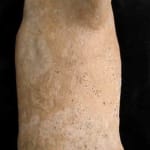Mayan Sculpture Mold, 300 CE - 900 CE
Terracotta
7.5 x 2.125
PF.6100b
Further images
This work of art, an ancient sculptor’s mold, grants us a unique insight into the creative process of Mayan artists. Such a mold would have been used in the fabrication...
This work of art, an ancient sculptor’s mold, grants us a unique insight into the creative process of Mayan artists. Such a mold would have been used in the fabrication of small terracotta sculptures. Pressed into the wet clay, the intricately carved pattern of the mold would be replicated. The highly detailed pattern of the interior belies the smooth, curved forms of the abstract exterior. This particular mold replicates the front half of an avian deity. He stands with the form of a human body, but features the head of an arch beaked bird, replete with a featured headdress and decorative ear spools. It is also likely that this mold depicts a priest or king disguised as the avian god. His hands are joined together just above his stomach where a belt and loincloth cover his genitals. This little mold, as functional as it is, even today, was once used to create images of gods. That idols worthy of worship could be created from this mold implies that the mold itself has some inherent power. Clearly, in the hands of a master sculptor, this mold has the power to embody and give form to the gods. Today, this mold is a relic of ancient artistry, transplanted from an ancient Mayan workshop into our hands, linking us directly with the creative process of long forgotten sculptors.





